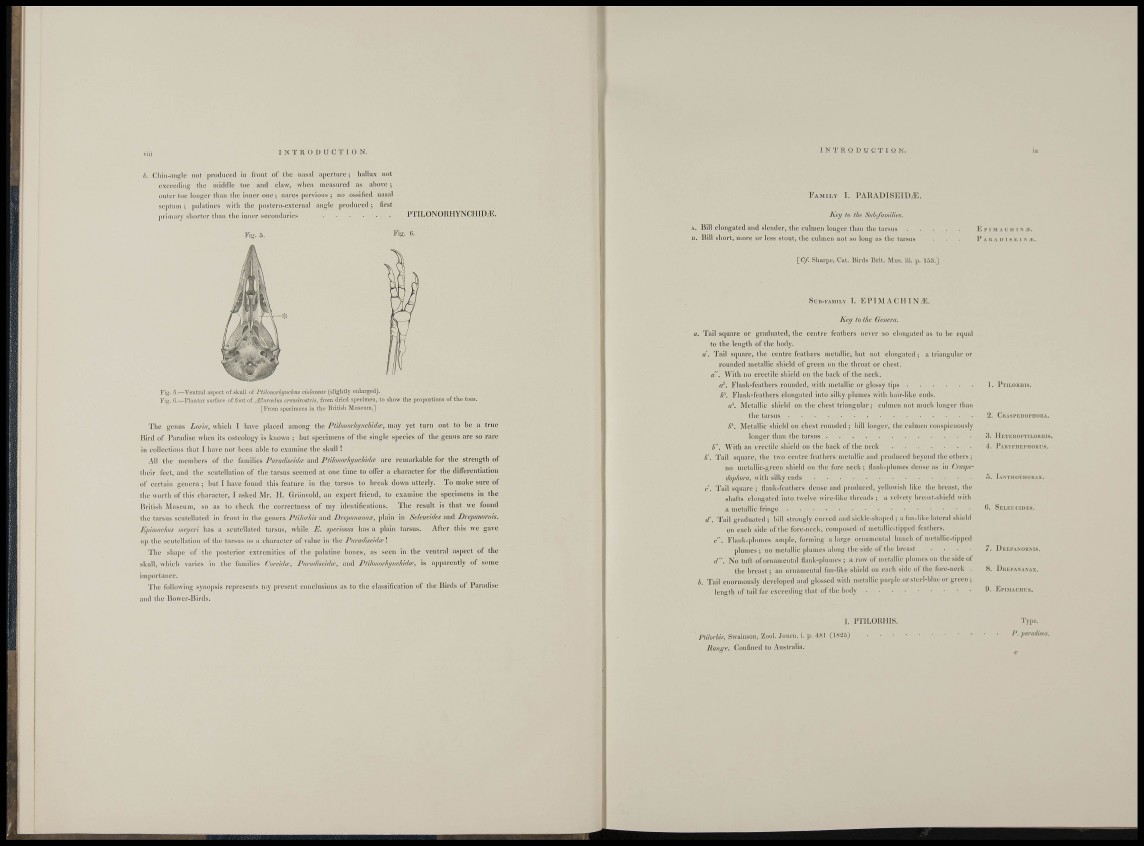
I N T R O D U C T I O N .
h. Cliiii-iiiigle not produced In front oF tlie nasiil aperture; hiillux not
exceeding' tile middle toe and claw, when nieasnred as ahove ;
onter toe lonifer than the inner one ; nares pervions ; no ossified nasal
s e p t u m : |)alatincs with the postero-external angle j)rodnced; first
primary shorter than the inner secoiHlaries P T I L O N O R H Y N C H I D / E .
Fiii. 5. Fig. 6.
Fig. 0.—Ventral asiiect of skull ot Ftilonorhjnclms molaeeus (sligMly enlai-ged).
Pig, C.—riaiitar snrfnco of foot of JUamlus crassimstris, from drietl specimen, to show the proportions of the toes.
[From specimens in the British Musenra J
T h e genus Luri/i, which I have placed among the Ptilojwrlujndudie, may yet turn out to be a true
l?ird of l^iradise when its osteology is known ; but specimens of the single species of tlie genus are so rare
in collections that I have not been able to examine the skull !
All the members of the families Paradisekkc and PtilonorkjncMda are remarkable for the strength of
their feet, and the scutellatiou of the tarsus seemed at one time to offer a character for the differentiation
of certain genera ; but I have found this feature in tbe tarsus to bi-eak down utterly. To make sure of
t h e worth of this character, I asked Mr. H. Gronvold, an expert friend, to examine the specimens in the
l i r i t i sh Museum, so as to check the correetuess of my identifications. The result is that we found
t h e tarsus sciitellated in front in the genera Plilorhis and Drepananax, plain in Seleiicides and Drepmiornn.
Epimnchus metjeri has a scutellated tarsus, while E. speetosm has a plain tarsus. After this we gave
lip tlie scutellatiou of the tarsus as a character of value in the Paradisehke\
T h e shape of the posterior extremities of the palatine bones, as seen in tlie ventral aspect of the
skull, which varies in tbe families Cvrmdce, Parudiseida, and Ptihnmhijiiohida:, is a]iparciitly of some
importance.
T h e folloiving synopsis represents my ])resent conclusions as to the classification of the Birds of Paradise
and tbe Bower-Birds.
I N T H O D U C T 1 O N.
FAMILY I. PARADISEIDiE.
Key to the Sub-families.
A. Bill elongated and slender, the culmen longer than the tarsus .
B. Bill short, more or less stout, the culmen not so long as tlie tarsus
[ C / . Sharpe, Cat. Birds Brit. Mus. iii. p. 153.]
E ? I -M A C M I N LI.
P A K A 1) R S K I \ «..
S U B - F A M I L Y I. E P I M A C H I N m .
Key to the Genera.
a. Tail square or graduated, the centre feathers never so elongated as to be equal
to the lengtb of tbe body.
d . Tail square, tlie centre feathers metallic, but not elongated ; a triangular or
rounded metallic shlekl of green on the tbroat or chest.
a . With no erectile shield on tbe back of the neck.
a ' . Flank-feathers rounded, with metallic or glossy tips 1. PTILORHIS.
F l a n k - f e a t h e r s elongated into silky plumes with hair-like ends.
Metallic shield on the chest triangular; culmen not much longer than
t h e tarsus 2. CHASPEDOPHORA.
¿•'. Metallic shield on chest rounded ; bill longer, the culmen conspicuously
longer than the tarsus ii. HETEKOPTILORHIS.
b". With an erectile shield on the back of the neck 4. PARVPHEPHOROS.
h'. Tail square, the t\\o centre feathers metallic and jjrodnced beyond the others ;
no metallic-green shield on the fore neck ; flank-plumes dense as in Craspedophora,
with silky ends 5. IA.NTHOTHOKAX.
(•'. Tail square ; tlank-fcathers dense and jiroduced, yellowish like the breast, tbe
shafts elongated into twelve wire-like threads ; a velvety brciist-sbicld with
a metallic fringe SELEUCIUES.
(/'. Tail gniduated ; bill strongly curved and sickle-shaped ; a fan-like lateral shield
on each side of the fore-neck, composed of metallic-tipped feathers,
c". Flank-plumes ample, forming a farge ornamental bunch of metallic-tipped
p l u m e s ; no metallic plumes along the side of the breast . . . . 7. DBEPANORMS.
d". No tuft of o rnamental tlank-plumes ; a row of metallic pliiuies on the side of
t h e breast ; an ornamental fan-like shield ou each side of the fore-neck . 8. DREPANAXAX.
b. Tail enormously developed and glossed with metallic jJurple or steel-blue or green ;
lengtb of tail far exceeding that of the body 9- EPI.IIACHUS.
]. PTILORHIS.
Ptilorhis, Swainson, Zool. Journ. i. p. 481 (1825)
liange. Confined to Australia.
Type.
P. paradisea.